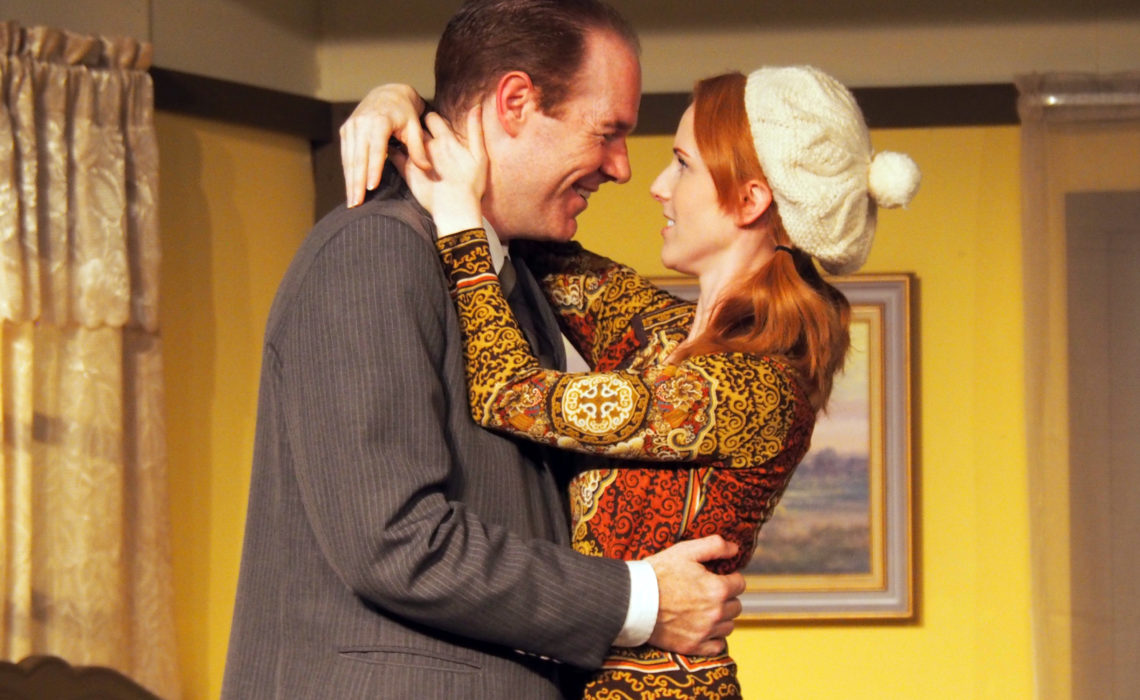In Same Time, Next Year, Bernard Slade’s romantic comedy about a recurring illicit relationship, the audience is required to accept the premise that an annual tryst between two adulterers that lasts for a quarter century is not only possible, but believable. This acceptance on the part of the audience is the key to the success of the show, but history tells us that since its Broadway debut in 1975, audiences have enthusiastically embraced the fantasy storyline, playing over 1,400 performances in its initial run (starring Ellen Burstyn and Charles Grodin) and retaining its popularity ever since. The Elite Theatre Company’s current production, which plays through July 1, utilizes the talents of Jennifer Ridgway and Kevin Ellis in portraying the two perpetual lovebirds, who shack up in a seaside cottage north of San Francisco in 1951 and return every year to rekindle their relationship and relate both the highlights and challenges each faces in their respective mundane suburban lives back home. The play consists of six scenes spaced in five-year intervals that show the changes, both physically as each partner ages, as well as their emotional growth through the years.
Same Time, Next Year is similar in structure to two other era-spanning romantic comedies, A. R. Gurney’s Love Letters and the Tom Jones/Harvey Schmidt musical I Do! I Do, in that only two actors are used for the entire play. But they also share something else: a tradition for starring real-life couples in the roles. Such is the case with Ridgway and Ellis, two extremely likable and talented actors who are also partners in real life. We’ve seen them in a variety of plays, mostly at the Simi Valley Cultural Arts Center, with both Ridgway and Ellis exhibiting remarkable comedic skills working within ensemble formats. On their own, they are equally delightful. The audience couldn’t care less that their characters, George and Doris, are married with children. In each scene we want to see them together again and catch up (as they do as well) on how life has treated them since their previous meeting. Initially infatuated with each other, the couple eventually become close friends as well as lovers, sharing their innermost secrets and fears about their relationship as well as their lives outside their annual weekend flings at the cottage. This begs the nagging question that results from the show’s preposterous premise: if they enjoy each other’s company so much, why do they do this only once a year? Although they both agree that their relationship has “no cares, no ties, and no responsibilities,” this is obviously not the case, as they not only are expected to show up every year, they often argue, make up, and show devotion to one another in each scene. Such a recurring relationship would be expected to end up in divorce with their respective spouses, but George and Doris are devoted to their marriages and we are led to believe that their serial adultery is their only vice.
Setting all this aside, producer L. J. Stevens and director James C. Stevens, an amicably divorced couple themselves, have created a lovely, heartfelt, and beautifully staged production. They have eschewed the obvious problems in aging a couple by a quarter of a century by not bothering with elaborate makeup changes from scene to scene. The youthful, slender Ridgway is fully padded for the 1961 scene in which she is eight months pregnant (probably the funniest segment in the play), dons a platinum blonde wig for another, and wears a paisley blouse in the scene from 1965, during which she is going through a pre-hippie, love child phase. As Doris ages, Ridgway’s flowing red hair is bundled up in a bun, which is all that is done to create the impression of middle age. As for Ellis, he goes through even less of a change – adding a mustache for one scene, but without adding graying temples or much of anything to indicate the passage of time. We are meant to accept the premise of their perpetual youth just as much as the far-fetched storyline for the sake of their relationship, which we want very much to believe.
In the beginning, George is a walking ulcer, wracked with guilt over his cheating ways, while Doris is more chipper about the whole thing, telling George she prefers to sublimate her guilt. The most pronounced change in their personalities occurs in the 1965 scene, when George and Doris are at odds in dress as well as attitudes. George has become a three-piece-suited Goldwater acolyte while free-spirited Doris uses phrases like “let it all hang out” and “uptight” in her language and is furious at George’s evolution into a money-minded establishment Republican . By the time their next tryst rolls around, both have reverted back to their previous personae, with each becoming more comfortable with their status in life.
At its best, Slade’s dialog crackles with Neil Simon-like wit as director Stevens takes advantage of Ridgway and Ellis’ razor sharp comedic timing. But it’s their moments of anger and passion that make their performances real and believable, a byproduct of the comfortable chemistry of having authentic couples perform opposite one another. They understand everything George and Doris are going through and can easily communicate this to the audience.
The songs used to represent each epoque are accurate and well-chosen. In the initial scene, which takes place in 1951, Rosemary Clooney’s lively, quirky harpsichord-spiked “Come On-A My House” is used to represent the couple’s fiery, hormonal attraction for one another. In the next scene, Fats Domino’s “Blueberry Hill” (1956) represents their deepening love. For the 1961 offering, Stevens chose the Shirelles’ hopeful but insecure “Will You Still Love Me Tomorrow,” while the Byrds’ “Turn! Turn! Turn!” mirrors the couple’s drastically changed attitudes in the volatile mid-60s. By 1970, George and Doris have become best friends, indicated by Michael Jackson’s supportive “I’ll Be There.” For the final scene in 1975, Barry Manilow’s “Looks Like We Made It” puts a fitting stopper in the show’s bottle, as George and Doris’s affair has survived nearly a quarter century, with their love and respect for one another remaining intact.
Same Time, Next Year may have an unbelievable, illogical premise, but once you set that aside, it’s fun to ride the waves of emotions felt by George and Doris as the years roll by. In addition to helming the production, L. J. and James Stevens also provide the props, set design, set dressing, costumes, and sound, deserving as much credit for the behind-the-scenes effectiveness of the play as Ridgway and Ellis do for their marvelous performances.
*********************
Same Time, Next Year plays through July 1 at the Elite Theatre Company in Oxnard. For tickets, call (805) 483-5118. For dates and show times, see the VC On Stage Calendar.






No Comments